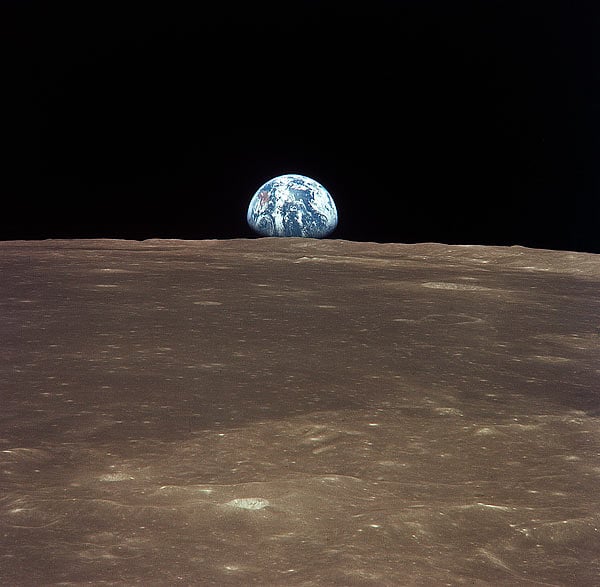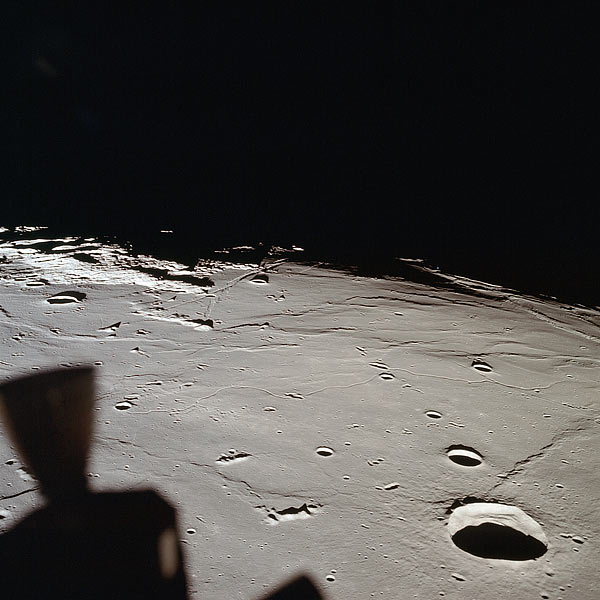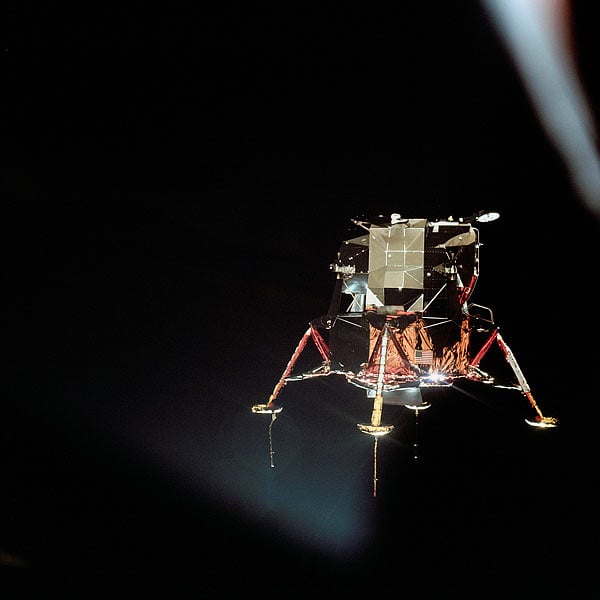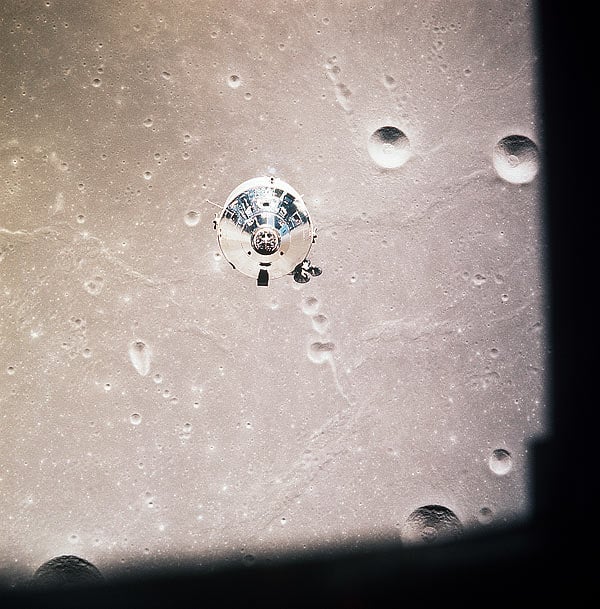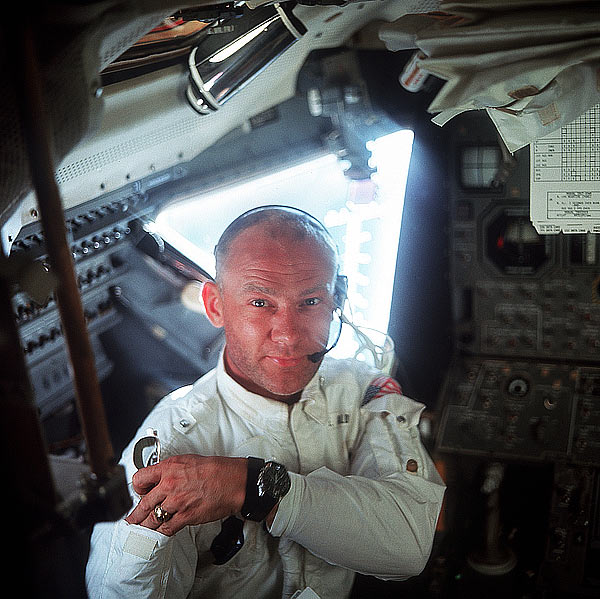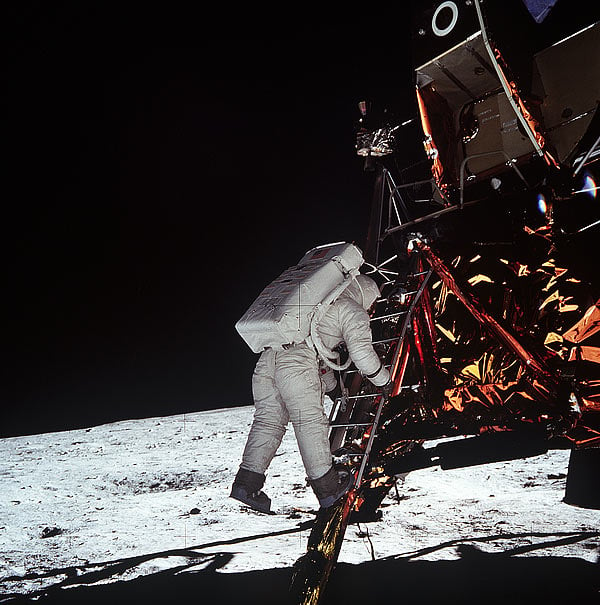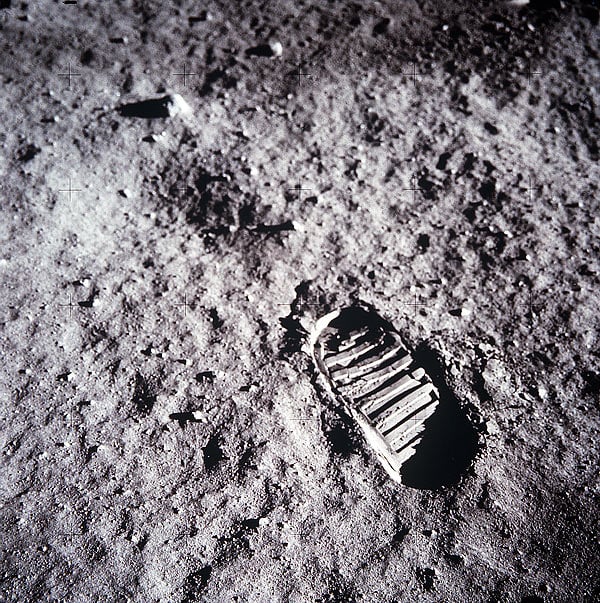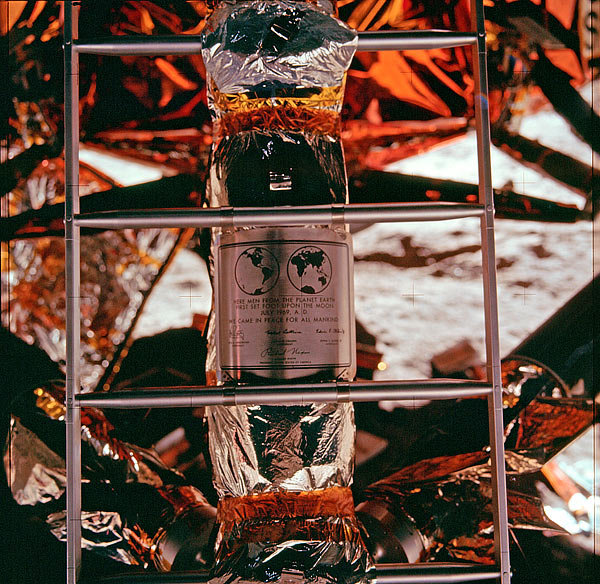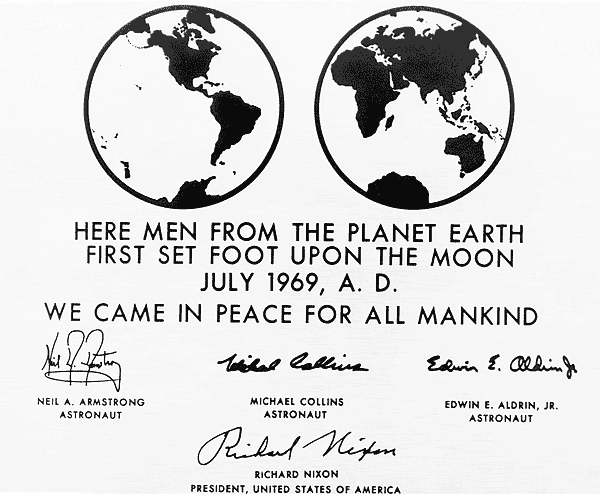Home Donate New Search Gallery How-To Books Links Workshops About Contact
20 July 1969:
The End of Impossible
© 2009 KenRockwell.com. All rights reserved.
Apollo XI entered Lunar orbit yesterday, 19 July. With each orbit, they saw the Earth rise over the lunar surface.
THey had so much to do that it took them a while to find a clean window and have a free hand to make some snaps, and here is one series shot at f/5.6 and 1/250 with the Zeiss Sonnar 250mm f/5.6 on the Hasselblad:
Earthrise from Apollo. bigger.
While orbiting the Moon today, 20 July, Commander Neil Armstrong and Lunar Module Pilot Buzz Aldrin climbed into the Lunar Module for a final checkout all LEM and space suit functions. Command Module Pilot Micheal Collins remained in the Command Module.
The approach to Landing Site 2 on the Moon, as seen from the Lunar Module as they orbited. (The Command Module is in the foregrond.) bigger.
Landing Site 2 is in the southwestern Sea of Tranquility. When this picture was made, the LEM was still docked to the Command and Service Modules (CSM). Site 2 is located just right of center at the edge of the darkness. The crater Maskelyne is the large one at the lower right. Hypatia Rille (U.S. 1) is at upper left, with the crater Moltke just to the right (north) of it. Sidewinder Rille and Diamondback Rille extend from left to right across the center of the picture. This view looks generally west.
11:11:53 PDT (2:11:53 PM EDT or 18:11:53 UT): LEM Undocking
The Lunar Module erected its landing gear and separated from the Command and Service Module.
Michael Collins gave the Lunar Module a visual inspection from the Comanfd Module to be sure that it hadn't been damaged during the flight.
The Eagle has wings. bigger.
The Eagle, nickname fot the LEM, is undocked and free from the Command and Service Modules. It is flying on its own at Missiom Elapsed Time (MET) 100:17:59.
The Apollo 11 Lunar Module (LEM) in its lunar landing configuration, which has both the bottom half (descent stage) and top half (ascent stage) connected.
The protrusions connected to the landing pods are five-foot long (1.5m) sensors to aid in the touchdown or landing process.
Inside the LEM are astronauts Neil A. Armstrong, commander, and Edwin E. Aldrin Jr., lunar module pilot. Michael Collins, command module pilot, remained with the CSM in lunar orbit and snapped this photo.
The CSM as seen from the LEM just before it starts to descend. bigger.
12:08PM PDT (3:08 PM EDT or 19:08 UT): Begining of Powered Descent
At MET of 100:06:33:07, the Lunar Module descent engine fired for 30 seconds putting the Lunar Module into a descent orbit with a closest approach 9 miles (14.5 km) above the Moon's surface.
Buzz Aldrin inside the LEM during the lunar descent. bigger. (photo: Neil Armstrong, commander, NASA)
Now is not the time to discuss this, but if you look at the left side of the image, you can see a perfect example of awful bokeh. THe glint of light on each switch has turned into a donut instead of a nice, soft circle.
1:05 PM PDT (4:05 PM EDT or 20:05 UT): Final Approach for Landing
The Lunar Mudule descent engine fired for 12-1/2 minutes (756.3 seconds) to slow the craft as it fell out of space and into the moon. Controlled descent to the lunar surface began.
As they were decending, Armstong noted that they were passing marks 4 seconds ahead of plan, meaning that they would land long of the numbers and be miles away from where they had planned to land.
About 8 minutes before landing, the computer startted throuwing out error messages which had never been seen before. The astronauts had traind to cover every possibly conceivable error, and this is one that was considered so remote by the program that it was never cvered in training.
In spite of these errors (program alarm 1202 and 1201 starting at MET 100:06:38:22), Armstrong continued his descent into relativly uncharted landing areas.
Since the LEM had to land a little further away than anticipated, it was running low on fuel. As the LEM decsnded under Armstrong's control, he was having to deal with these program alarms which were caused for unknown reasons, and a rapidly dwindling feul supply.
Appollo control let him know they asked the computer guys, who told him that so long as these errors, caused for unknown reasons, didn't stay up constayly, that he was still GO.
With all these errors popping up, Armstrong turned off the computer that was supposed to help him fly this thing.
Armstrong was now flying VFR by the seat of his pants, trying to find a place to land without landing on a big rock and having only seconsds of fuel left.
What "seconds of fuel left" means is that if he didn't put it down within these last seconds, that he would either have to abort the entire mission and return to the Command and Service Module, or that if he kept on, he could run out of the fuel needed to land safley (in other words, crash into the Moon), or try to land on whatever he could find and pray he didn't hit a rock.
Hitting a rock would be bad. If the LEM didn't land upright, they would not be able to launch back up to the Command and Service Module, and they would not likely be able to get out of the LEM and onto the moon. Even if they got out onto the Moon, they would not be able to return and would be left to die in space as the world watched helplessly.
The Hell with that. Armstrong kept on going down.
1:17:40 PM PDT (4:17:40 p.m. EDT or 20:17:40 UT): Landed
The LEM landed at Mare Tranquilitatis (the Sea of Tranquility).
Armstrong reports "Houston, Tranquility Base here. The Eagle has landed." Whoo Hoo!
Armstrong had only 30 seconds of fuel left. As I heard later in his verbal description of what went through his mind after all this, he said that after this and landing on the moon, he knows that he will never agaion let anyone tell him anything is impossible. THis showed him that no such think as "impossible."
7:56:15 PM PDT (10:56:15 p.m. EDT or 02:56:15 UT next day): They got out.
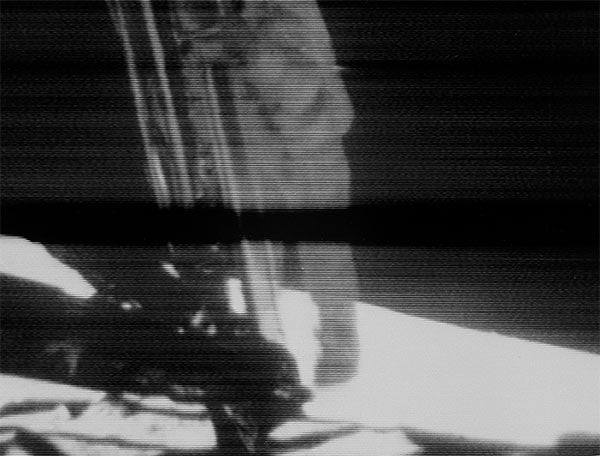
Neil Armstong's First Step on the Moon. (as seen on on TV.)
Armstrong stepped onto the lunar surface, saying: "That's one small step for man, one giant leap for mankind."
As the most important even in all of human history, one-sixth of the entire population of Earth watched it live on TV. TV was still in its infancy. People lucky enough to have TVs only had B&W TVs.
Buzz Aldrin steps out and descends to the surface of the Moon. bigger.
Buzz Aldrin followed 19 minutes later, as Neil Armstrong snapped this with the Hasselblad.
The astronauts deployed the EASEP and other instruments, took photographs, and collected 50 pounds (21.55 kg) of lunar rock and soil.
Aldrin on the Moon. bigger.
AS11-40-5903 (20 July 1969) --- Astronaut Edwin E. Aldrin Jr., lunar module pilot, walks on the surface of the moon near the leg of the Lunar Module (LM) "Eagle" during the Apollo 11 extravehicular activity (EVA). Astronaut Neil A. Armstrong, commander, took this photograph with a 70mm lunar surface camera. While astronauts Armstrong and Aldrin descended in the Lunar Module (LM) "Eagle" to explore the Sea of Tranquility region of the moon, astronaut Michael Collins, command module pilot, remained with the Command and Service Modules (CSM) "Columbia" in lunar orbit.
THe placque on the LEM. bigger.
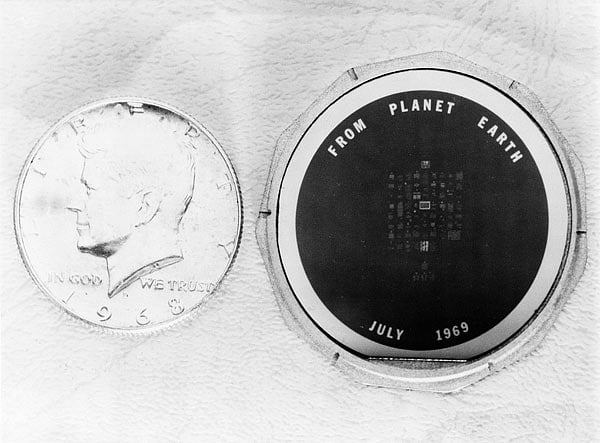
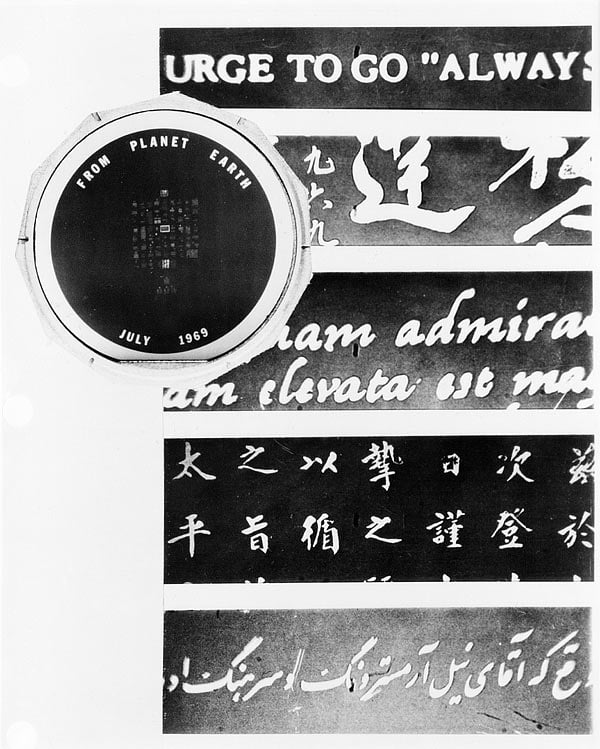
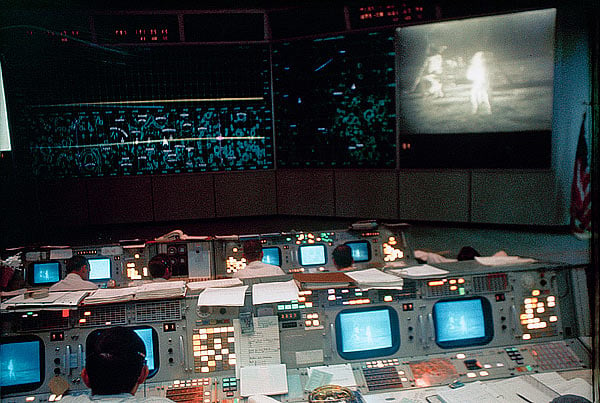
The astronauts traversed a total distance of about 800 feet (250 meters).
10:11:13 PM PDT (1:11:13 AM EDT or 5:11:13 UT next day): They got back in.
The EVA ended at when the astronauts returned to the LM and closed the hatch.

Neil Armstrong in the LEM as they are ascending back to the CSM.
Help me help you top
I support my growing family through this website, as crazy as it might seem.
If you find this as helpful as a book you might have had to buy or a workshop you may have had to take, feel free to help me continue helping everyone.
If you've gotten your gear through one of my links or helped otherwise, you're family. It's great people like you who allow me to keep adding to this site full-time. Thanks!
If you haven't helped yet, please do, and consider helping me with a gift of $5.00.
The biggest help is to use these links to Adorama, Amazon and eBay when you get your goodies. It costs you nothing and is a huge help to me. eBay is always a gamble, but all the other places have the best prices and service, which is why I've used them since before this website existed. I recommend them all personally.
Thanks for reading!
Ken
Home Donate New Search Gallery How-To Books Links Workshops About Contact
